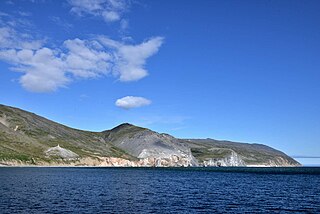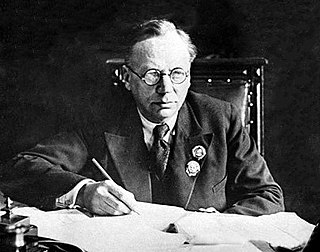Related Research Articles

Cape Dezhnyov or Cape Dezhnev, formerly known as East Cape or Cape Vostochny, is a cape that forms the easternmost mainland point of Asia. It is located on the Chukchi Peninsula in the very sparsely populated Chukotka Autonomous Okrug of Russia. This cape is located between the Chukchi Sea and the Bering Strait, 82 kilometres (51 mi) across from Cape Prince of Wales in Alaska; the Bering Strait is delimited by the two capes. The Diomede Islands and Fairway Rock are located in the midst of the strait.

The Northeast Passage is the shipping route between the Atlantic and Pacific Oceans, along the Arctic coasts of Norway and Russia. The western route through the islands of Canada is accordingly called the Northwest Passage (NWP).
Dezhnev may refer to:

Komet (HSK-7) was an auxiliary cruiser of Nazi Germany's Kriegsmarine in the Second World War, intended for service as a commerce raider. Known to the Kriegsmarine as Schiff 45, to the Royal Navy she was named Raider B.
Komet is the word for comet in some languages and may refer to:

Vladimir Yulyevich Wiese was a Russian scientist of German descent who devoted his life to the study of the Arctic ice pack. His name is associated with the Scientific Prediction of Ice Conditions theory. Wiese was a member of the Soviet Arctic Institute and an authority on polar oceanography. He was also the founder of the Geographico-hydrological School of Oceanography.

The icebreaker Fyodor Litke was active in the Soviet era in the Arctic, until the late 1950s. It was built in 1909 in England for the Saint Lawrence River service and initially named CGC Earl Grey after Albert Grey, Governor General of Canada. After four years in Canada it was sold to the Russian government and eventually renamed Fyodor Litke in honour of the Arctic explorer Fyodor Petrovich Litke.

Operation Wonderland was an operation from 16 to 30 August 1942 by the Kriegsmarine in the Barents Sea and the Kara Sea off the Arctic coast of the Soviet Union. The operation was an attack on Soviet shipping using the Northern Sea Route which ran along the Soviet Arctic coast from the Bering Strait, westwards along Siberia to the Kara Sea. The operation was the first part of a campaign to dominate the seas of the western Arctic. Reports from Japanese naval intelligence alerted the Germans to the sailing of a convoy, EON-18.

Tarmo is a Finnish steam-powered icebreaker preserved in the Maritime Museum of Finland in Kotka. Built in 1907 by Sir W.G. Armstrong, Whitworth & Co Ltd in Newcastle upon Tyne, United Kingdom, she was the third state-owned icebreaker of Finland and the last Finnish steam-powered icebreaker to remain in service. When Tarmo was decommissioned in 1970, a decision was made to preserve the vessel as a museum ship. After a long wait in Helsinki, Tarmo was towed to Kotka and completely restored in the early 1990s.

The first icebreaker Krassin, or Krasin, was built for the Imperial Russian Navy as Svyatogor. She had a long, distinguished career in rescue operations, as well as a pathfinder and explorer of the Northern Sea Route. She has been fully restored to operating condition and is now a museum ship in Saint Petersburg.

Fedot Alekseyevich Popov was a Russian explorer who organized the first European expedition through the Bering Strait.
Malygin (Малыгин) may refer to one of the following icebreakers:

Suur Tõll is an Estonian steam-powered icebreaker preserved in the Estonian Maritime Museum in Tallinn. She was originally built for the Russian Empire in 1914 by AG Vulcan in Stettin, Germany, as Tsar Mikhail Feodorovich. In 1917, she was taken over by the Bolsheviks and renamed Volynets. However, in 1918 she was captured by Finland and served as Wäinämöinen until 1922, when she was handed over to Estonia according to the Treaty of Tartu and renamed Suur Tõll. When Estonia was occupied by the Soviet Union in 1940, the icebreaker rejoined the Soviet fleet and was again named Volynets. She remained in service until 1985.
Ural may refer to the following vessels:
Three icebreaking ships have been named Sibir:
Ilya Muromets may refer to one of the following icebreakers named after the Russian folk hero:
Three icebreakers have been named Georgiy Sedov:

Project 97 icebreakers and their derivatives are a diverse series of diesel-electric icebreakers and other icebreaking vessels built in the Soviet Union. In total, 32 vessels were built in various configurations for both civilian and naval service in the 1960s, 1970s and early 1980s, and several remain in service in Russia as of 2023.
Semyon Chelyuskin was a Soviet icebreaker in service from 1965 until at least 1988. It was one of twelve Project 97A icebreakers built by Admiralty Shipyard in Leningrad in 1961–1971.
Semyon Dezhnev is a Russian icebreaker. It is the last of twelve Project 97A icebreakers built by Admiralty Shipyard in Leningrad, Soviet Union, in 1961–1971.
References
- ↑ Philbin III, Tobias R., The Lure of Neptune: German-Soviet Naval Collaboration and Ambitions, 1919–1941, University of South Carolina Press, 1994, ISBN 0-87249-992-8, pp. 138–142.